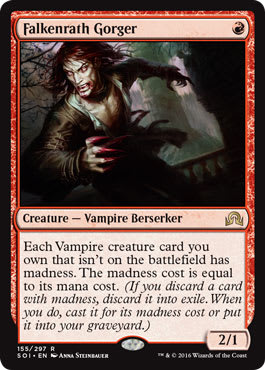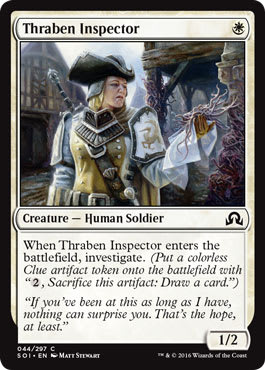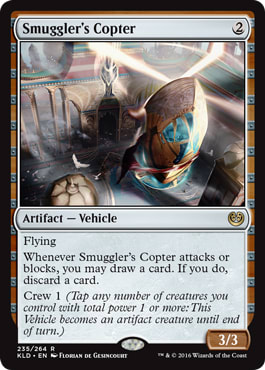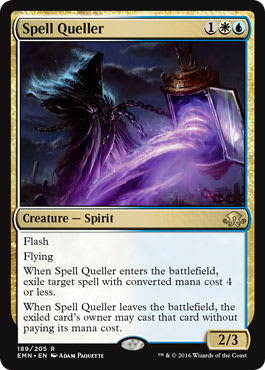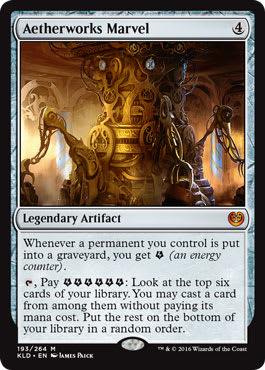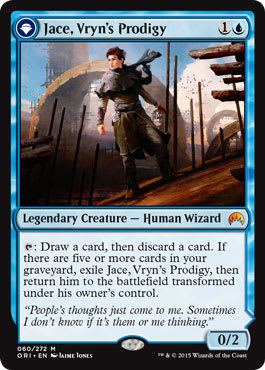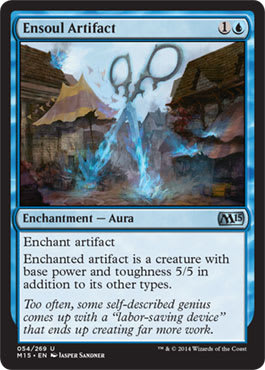It's unclear what Wizards of the Coast's exact motives are for having the Standard Showdown series this month. It might be to offer some holiday fun while organized play events drop off, to keep store attendance up during what is normally a slow period. I strongly suspect that the carrot of a free tournament series was used to test how receptive people were to a new type of prize, as the Standard Showdown packs offered the meat of booster packs without the cost of printing all the commons - the analog version of Magic Online's treasure chests.
But whatever motives — and however many motives — the one that most fits the popular narrative is that Wizards of the Coast is offering free Standard events because of declining attendance.
I doubt that's what happened — Standard Showdown likely was planned long before Kaladesh Standard existed — but that it can be interpreted as such indicates some problems. My local game store, which regularly gets 50 people to prereleases, had attendance from six to ten at Standard Showdown, even though it was the only Standard available for the month (they normally do Standard on Fridays as well, but the store tried Frontier in that slot this month to see if it would fare better.) Having a few Standard events fire over four Saturdays is an improvement over having a few Standard events fire over four months, but it's not a launching pad for the Great Standard Revival of 2017.
So what's up with Standard? What's hand-wringingly bad about it? And why are so many people wanting to wring hands about it? Why are free tournaments talked about as though they're apologies?
I think I know the answer. I haven't seen it offered anywhere else, but I've been sounding the warning on the problem several times this year.
The two-set block killed Standard.
How did it do that? Let's piece the story together with some understanding of choices made along the way and how they've played out since then.
The Switches
In August 2014, Mark Rosewater announced the change to Standard rotation and to the block model. In a nutshell, large sets would have a Standard shelf life of 18 months instead of 24, and blocks would have two sets instead of three. In that article, he discussed five issues with the status quo:
The Third-Set Issue — "It needs to have enough cohesion to feel as if it belongs to the block, but it has to have enough differences that it manages to spark the interest of the players, who have already been playing the environment for seven or more months."
The Core-Set Issue — "It's trying to make two different audiences happy at the same time and it's led to us making a set full of very odd compromises."
The Metagame Issue — "Formats, especially Standard, get solved faster because the ability for players to iterate and learn has greatly accelerated."
The Storytelling Issue — "Each block really wants to tell one story, which means that the overall pace of the storytelling is slow."
The Space Issue — "The success of [Return to Ravnica] block has opened the floodgates of players requesting returns to other worlds [ . . . ] There simply isn't enough space to do all the things we want to do."
The Buckets
For this article, I'm going to group those five concerns into three groups, because those groups turn out to pull Magic decisions in separate directions:
Limited Play — Limited play is where most players engage a block as an immersive whole, since more cards are seen here than anywhere else. It won't feel as immersive if its cards aren't widely playable and if there are only a few things to explore due to imbalance. Triple Innistrad is beloved as a Draft format because it hit those marks while having flavor people liked; the flavor didn't change when Dark Ascension was introduced, but the world of playable directions was smaller, so it's not as beloved.
Constructed Play — Constructed play engages a block through a block's mechanics. A mechanic might be entirely a Limited mechanic (outlast from Khans of Tarkir), a mechanic might reside mainly in Limited but promote its best cards to Standard (investigate from Shadows over Innistrad gave the world Thraben Inspector and Tireless Tracker), or a mechanic might be robust enough to promote an entire Standard strategy for its synergies (Vehicles from Kaladesh are currently in this category).
Creative/Marketing — Wizards's creative and brand teams have to build and then sell the notion that the new set is worth checking out, that it is sufficiently interesting for players to try. Once they try it, Limited and Constructed play take over the marketing in a sense. The assumption behind PAX hoopla is that, once people experience Kaladesh or some other set, they'll be eager to buy Kaladesh, and once people play Kaladesh, they'll want to keep playing it until the next thing comes out.
Of the five issues above, the third-set issue could be read as a Limited or Constructed problem or both. The metagame issue is, by Rosewater's own statement, largely a Constructed problem. But the core-set, storytelling, and space issues are creative/marketing team problems. So the two-set block and the 18-month rotation were meant to solve five issues together, of which the majority were creative/marketing problems and a minority related to Limited and Constructed game play.
The Tug-of-War
So why does that matter? Because, of the three buckets, it turns out that creative/marketing issues and Limited play issues are both solved with world turnover. Instead of marketing having one block story to hype every year, it gets two. Instead of Limited immersing players in a world (one block) and a non-world (most core sets) every year, it immerses players in two worlds. Marketing and Limited players enjoy the two-set block because it gives them a greater variety of things to do in a year. Without question, the changes Rosewater announced are great for those two areas.
But the way in which those turnovers occur, and the extent to which they need to occur, are directly harmful to Standard play. The typical Standard deck has a choice to build for power/efficiency (they're the same idea for my purposes: the best card at each converted mana cost) or synergy. Power/efficiency always exist with any pool of cards — there is going to be a right answer or couple of answers in each color, and there might be a completely right answer for that pool. Synergy requires a critical mass of an effect in order to build with it, whether it's tribal (Slivers), color-based (White aggro when Honor of the Pure was in Standard), or something else where one card wants you to have another card or cards to go with it.
Synergy decks require that critical mass, and if the synergy in question is block-specific, that synergy is served better with three-set blocks – the opposite of what's good for Limited and marketing! Although a compromise in theory could be reached by having blocks overlap well, there are many synergies, particularly tribal ones, where the excitement of a new world would be dimmed from a marketing standpoint by diluting that world with the crossovers. This was the approach taken with Eldritch Moon, adding Eldrazi into various tribes, but that only helped the Eldrazi rather than help Innistrad out. As an example, here are how many of the main creature types from Shadows over Innistrad are in Standard:
- Human - 132
- Vampire - 47
- Spirit - 32
- Zombie - 28
- Werewolf - 20
It's not exactly a mystery why Thalia's Lieutenant has had more success than Falkenrath Gorger, or why Mausoleum Wanderer and Cryptbreaker haven't been seen much for awhile. Any Human synergy card will have Humans in every block to work with it, but Vampires have only two of the three Standard blocks right now and the other creature types have just the one. Assuming for sake of argument that Falkenrath Gorger and Thalia's Lieutenant are equally good incentives to building in those tribes, the numbers difference makes one of them playable in Constructed and the other much less so. If Falkenrath Gorger had 131 other Vampires to choose from, maybe we'd see it often as Thalia's Lieutenant.
The Effects
Because each block wants to do something new for the sake of marketing and Limited play, there are more Falkenrath Gorgers than Thalia's Lieutenants. And that pushes Standard to a power/efficiency format. Consider W/U Flash for a moment: it has the best 1-drop in Standard in Thraben Inspector, the best 2-drop in Smuggler's Copter, arguably the best 3-drop in Spell Queller, the former best 3-drop in Reflector Mage, and one of the two best 4-drops in Gideon, Ally of Zendikar. There's no major synergies between any of them; it plays the best cards it can. Because it has no major synergies, it doesn't feel like a deck that belongs to a Standard format; there's no identity to it over anything else. It's just the U/W good stuff that exists in this space.
The two-set block makes more of these decks than synergy decks, and we're feeling the effects of that now. Now you might be asking, "Brandon, aren't B/G Delirium and R/G Marvel decks clearly about synergy?" Well . . . yes and no. B/G Delirium is primarily a Shadows over Innistrad deck using one of the block's flagship mechanics; that meets the definition of a synergy deck. However, that synergy is not Falkenrath Gorger-style synergy because of what delirium is: having various card types in your graveyard. Graveyards naturally get bigger as any game of Magic progresses; Shadows over Innistrad helps players do that quicker, but any deck with fetch lands, creatures, instants, and another card type could hit delirium without any enablers or payoffs.
And while Aetherworks Marvel decks showcase Kaladesh energy synergies, the cards that Aetherworks Marvel wants to hit the most are part Eldrazi and part delirium payoffs. Both B/G Delirium and R/G Marvel are decks with a lot of finicky setup time and early removal so that, once enough of the setup cards are in the graveyard, Ishkanah, Grafwidow and Emrakul, the Promised End do the heavy lifting. The decks disagree on the journey but agree on the destination, so to speak, and to that end it's hard for me to call their synergies distinct in a way that gives them fully separate identities.
Now Mardu Vehicles is definitely a good synergy deck; if more decks in Standard had synergy and flavor identities as strong as Mardu Vehicles has, it would be pretty vibrant. But as it is, synergy decks need powerful enough incentives to exist in two-set-block Standard while having a critical mass of overlapping effects large enough to be worth playing over decks like W/U Flash that are made entirely of curve considerations.
If the synergy is extremely open-ended like delirium, it will be fine; otherwise, it's going to need enough enablers in just two sets to get there — which has a chance of making Limited play too repetitive because those enablers are stronger than anything else going on. To give Limited players varied things to do requires spreading synergies, and with two sets per block there isn't a high enough concentration of most synergy cards to turn them into Constructed decks.
The Concerns
For most Standard deck-builders who want to give their deck an identity — the same tie to a world that Limited play and the marketing incentivize players feeling — that identity is not as good as jamming on-curve cards and going to town. Aetherworks Marvel's best payoffs aren't more energy cards; Olivia, Mobilized for War is Olivia, Sitting in Binders; Ally Encampment and Corrupted Crossroads are junk rares despite being amazing mana fixers for their strategies. Magic's life cycle moves too quickly out of a concept to give Standard decks with strong ties to a particular world they come from. If Limited and marketing create a welcoming garden, then Standard right now is the sterile hospital — and not even the Garth Marenghi's Darkplace kind of hospital. Standard's never been marketable as such, but three-set blocks gave enough marketing bleed from Limited that Standard felt like it represented distinct worlds. Two-set blocks are struggling mightily with this, and until it figures out how to fix this without distorting Limited, Standard will continue to feel like a hospital.
The Year of Mentioning Them
On January 6, I said on this site:
And on June 15, I said on this site:
Those statements ring truer to me now than when I typed them. And reverting to a 24-month shelf life for half of the large sets takes one of the two prongs behind the original changes and doesn't help unless the blocks tie together — which, again, cuts into Limited and marketing goals.
The Next Year of Greatness?
But there is an upside to all this. If Wizards of the Coast can seed more synergy incentives into sets without breaking Limited — and the smaller set of a block is a great place to put more of the hand-holding cards because the world creative/marketing wanted has already been laid out and players have already been immersed in it — then Standard could get to a healthier place than ever. If each block equally has a deck or decks with an identity in Standard, then Standard will have three or four worlds to make that identity at any given time, as opposed to the two worlds it had in the era of three-set blocks. If Friday Night Magic Standard could have Allies, Delirium, Vehicles, and whatever is in Amonkhet as equally viable decks, that would be quite the welcoming garden, a pick-your-favorite-world that allows players to jump from marketing and Limited into Constructed seamlessly.
The Competition
Having witnessed and brewed for Frontier at the Friday Night Magic level all month, I think it's that feel that's drawing players into it over Standard right now. It's not that Tarkir-era Standard was anyone's favorite; far from it. It's that there is a meaningful choice of feel in the decks made for Frontier, giving the decks far more identity than Standard allows right now. If you miss either of Tarkir's iterations, you can build around its flagship cards; if you want to see how Kaladesh, Magic 2015, and Magic Origins (the original spoiler of the Kaladesh world) play together in Ensoul Artifact-based aggro decks, that's available too. To the extent a block-centered strategy might have had a weak point, there's enough support cards from other sets to help fill it out while still feeling like it has an identity.
Is it a great format? I've enjoyed it well enough, but it hasn't bowled me over with its gameplay. What it has given is strong feelings of identity and personality among its decks, and that's what Standard is desperately missing right now. Marketing wants us to explore created worlds; Limited wants us to explore created worlds; Standard largely discourages exploring created worlds. Standard's disconnected because of how other decisions are being made, and the obvious ways to improve it come at the expense of marketing and Limited variety.
The Future
I obviously have no control over how Standard sets are designed; this week marks the second anniversary of leaving my contract with Wizards of the Coast a couple months early to take my current job. But I've been writing this column in the wake of all the changes, and to me it's as clear as can be that decisions made for healthy marketing and Limited play are at odds with healthy Standard play now. That creates a new version of the old core-set issue — " trying to make two different audiences happy at the same time" — but that's only because they've severed connections between the marketing/Limited and Standard audiences. If they reconnect them through their design decisions, then Standard should be a welcoming place once more. If not, then . . . I hope the hospital has a good cafeteria.
















